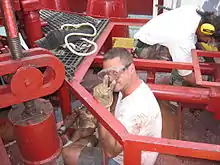Needlegun scaler
A needlegun scaler, needle scaler or needle-gun is a tool used to remove rust, mill scale, and old paint from metal surfaces.[2] The tool is used in metalwork applications as diverse as home repair, automotive repair and shipboard preservation.[3][4][5]

Operation and use
A needle gun has a set of very fine chisels known as needles.[3] The tool forces these needles against a work surface at variable speeds up to around 5,000 times per minute.[3][2] Different models offer choices of number of needles, operating speed, and power levels.[3] Many models use compressed air, although electrical needle-guns do exist.[3][6]
In a pneumatic unit, compressed air forces a piston forwards and backwards.[3] This movement causes the needles to move back and forth against the work surface.[3]

The needle gun has advantages over other scaling tools. Its main advantage is that the needles automatically adjust themselves to contours, making the tool a good choice for cleaning irregular surfaces.[2] A needle gun can clean an area to bare metal in seconds, and compares well to other scaling tools in terms of accuracy and precision.[3]
It is recommended that before needlegunning, a surface should be prepared by removing oil, grease, dirt, chemicals and water-soluble contaminants.[5] This can be done with solvents or with a combination of detergent and fresh water.[5] Then, the needle gun is used to remove rust, loose scale, and paint, leaving bare metal.[5] It is used most effectively by holding it at a 45° angle to the work surface.[5] It is recommended that an area no larger than six to eight inches be cleared at once.[5] Two to three passes over an area is generally sufficient to clean it.[5] Then the process is repeated until the desired area is completed.[5]
Prior to painting, it is desirable to feather any edges between metal and old paint.[5] It is also important to check the surface for oil deposited during chipping, and if necessary, clean the area with solvents.[5] Since bare metal surfaces will flash rust soon after exposure to the atmosphere, paint should be applied as soon as possible after chipping.[5] If flash rusting occurs prior to coating, further chipping, cleaning and sanding may be necessary.[5]
See also
Notes
- U.S. Navy, 2006.
- NETC, 2003, p. 11-10.
- Miller, 2008.
- Park, 1984.
- NAVSEA, 2008.
- Nitto Kohki, 2008.
References
- Miller, Jason (2008-01-30). "Needle Scaler and Debris Removal". Free Online Library. Free Online Library. Retrieved 2008-04-05.
- Naval Sea Systems Command (NAVSEA) (2008). "Chapter 7: Submarine Forces Afloat Painting and Preservation Guidelines for Non-Nuclear Spaces and Components". Contracted Ship Maintenance. Joint Fleet Maintenance Manual - Rev A Change 7. VI. United States Navy.—CHAP 7 LINK NO LONGER WORKS
- Naval Education and Training Command (NETC) (2003) [1996]. "Chapter 11: Painting". NAVEDTRA 14343: Boatswain's Mate (PDF). Nonresident Training Manuals. Pensacola, Florida: United States Navy. Retrieved 2008-04-05.
- Park, Sharon (1984). "#13: The Repair and Thermal Upgrading of Historic Steel Windows". Preservation Briefs. Government Publishing Office. Archived from the original on 2008-04-15. Retrieved 2008-04-05.
- Nitto Kohki (2008). "EJC-32A Electric Needle Scaler". nittokohki.com. Nitto Kohki USA. Archived from the original on 2008-06-15. Retrieved 2008-04-05.
- U.S. Navy (2006-03-23). "Eye on the Fleet". Navy NewsStand. United States Navy. Retrieved 2008-04-05.